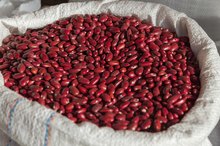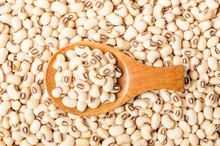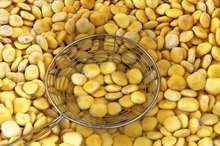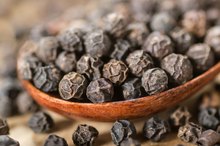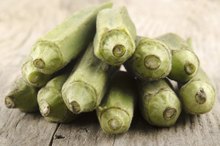Side Effects of Pinto Beans
Pinto beans can be a healthy protein source. Eating 1/2 cup of pinto beans adds 8 g of protein to your daily intake. You will also get 8 g of dietary fiber without any fat or cholesterol from 1/2 cup of plain cooked pinto beans. Eating large amounts of pinto beans, however, can cause side effects, both negative and positive.
Intestinal Gas
Pinto beans may cause intestinal discomfort and gas. Beans naturally contain gas-causing substances and large amounts of fiber, both of which can lead to an increase in stomach cramping and flatulence. The Centers for Disease Control recommends soaking dried beans and changing the soaking water several times to cut back on the gas-causing properties found in pinto beans. Canned pinto beans tend to produce less intestinal gas than dried beans as well. Talk to your doctor about taking an over-the-counter enzyme tablet before eating pinto beans to help reduce stomach discomfort.
- Pinto beans may cause intestinal discomfort and gas.
- The Centers for Disease Control recommends soaking dried beans and changing the soaking water several times to cut back on the gas-causing properties found in pinto beans.
Slowed Tumor Growth
Do Beans Have Iron?
Learn More
Pinto beans contain polyphenols, which are antioxidants that can prevent some forms of cancer, according to an article in the January 2005 issue of "The American Journal of Clinical Nutrition." Pinto beans specifically contain kaempferol, a flavonoid that helps reduce inflammation. The antioxidants found in pinto beans may slow the growth of tumors and increase the survival rate of healthy cells.
Increased Iodine Levels
If you suffer from thyroid cancer, your doctor may suggest that you avoid eating large amounts of pinto beans. Because thyroid cancer is treated with iodine radiation, avoid adding extra iodine to your diet during treatment. The Thyroid Cancer Survivors' Association states that pinto beans are naturally high in iodine. Consuming excess iodine during thyroid cancer treatment can reduce the effectiveness of the radiation because your body may not use all of the administered iodine in the treatment if your iodine levels are already high.
- If you suffer from thyroid cancer, your doctor may suggest that you avoid eating large amounts of pinto beans.
Reduced Heart Disease Risk
Weight Loss and Red Kidney Beans
Learn More
Consuming 1/2 a cup of pinto beans daily can help reduce your total cholesterol and LDL cholesterol levels, according to a study published in the June 2007 issue of the "Journal of the American College of Nutrition." Replacing a less healthy protein source, such as fatty meats, with pinto beans helps reduce unhealthy fats from your diet and also helps increase your intake of dietary fiber, both of which can help lower your cholesterol and possibly reduce your risk for developing heart disease.
Related Articles
References
- USDA; Polyphenolic Profiles of Three Beans Varieties; Devanand L. Luthria, et al.
- "The American Journal of Clinical Nutrition"; Polyphenols: Antioxidants and Beyond; Augustin Scalbert, et al.; January 2005
- PubMed.gov; Anti-Inflammatory Effects of Flavonoids; M. Hämäläinen, et al.
- Thyroid Cancer Survivors' Association: Radioactive Iodine
- Beans, pinto, dry. USDA Foods Product Information Sheet. U.S. Department of Agriculture. Published December 2015.
- Perry JR, Ying W. A review of physiological effects of soluble and insoluble dietary fibers. J Nutr Food Sci. 2016;6(2):1000476. doi:10.4172/2155-9600.1000476
- Sanders TA. How important is the relative balance of fat and carbohydrate as sources of energy in relation to health?. Proc Nutr Soc. 2016;75(2):147-53. doi:10.1017/S0029665115004188
- Chávez-Mendoza C, Sánchez E. Bioactive compounds from Mexican varieties of the common bean (phaseolus vulgaris): Implications for health. Molecules. 2017;22(8). doi:10.3390/molecules22081360
- Rebello CJ, Greenway FL, Finley JW. A review of the nutritional value of legumes and their effects on obesity and its related co-morbidities. Obes Rev. 2014;15(5):392-407. doi:10.1111/obr.12144
- McCullough ML, Peterson JJ, Patel R, Jacques PF, Shah R, Dwyer JT. Flavonoid intake and cardiovascular disease mortality in a prospective cohort of US adults. Am J Clin Nutr. 2012;95(2):454-64. doi:10.3945/ajcn.111.016634
- Ha V, Sievenpiper JL, de Souza RJ et al. Effect of dietary pulse intake on established therapeutic lipid targets for cardiovascular risk reduction: A systematic review and meta-analysis of randomized controlled trials. Can Med Assoc J. 2014;186(8):E252-E262. doi:10.1503/cmaj.131727
- Sievenpiper JL, Kendall CW, Esfahani A, et al. Effect of non-oil-seed pulses on glycaemic control: a systematic review and meta-analysis of randomised controlled experimental trials in people with and without diabetes. Diabetologia. 2009;52(8):1479-1495. doi:10.1007/s00125-009-1395-7
- Jacques PF, Cassidy A, Rogers G, Peterson JJ, Meigs JB, Dwyer JT. Higher dietary flavonol intake is associated with lower incidence of type 2 diabetes. J Nutr. 2013;143(9):1474-80. doi:10.3945/jn.113.177212
- Mudryj AN, Yu N, Aukema HM. Nutritional and health benefits of pulses. Appl Physiol Nutr Metab. 2014;39(11):1197-204. doi:10.1139/apnm-2013-0557
- Huang T, Zhang X, Liu C, Lou Y, Song Y. Dietary fiber intake and mortality from all causes, cardiovascular disease, cancer, infectious diseases and others: A meta-analysis of 42 prospective cohort studies with 1,752,848 participants. North Am J Med Sci. 2015;8(2):59-67. doi:10.7156/najms.2015.0802059
- Verma AK, Kumar S, Das M, Dwivedi PD. A comprehensive review of legume allergy. Clin Rev Allergy Immunol. 2013;45(1):30-46. doi:10.1007/s12016-012-8310-6
- Huber K, Brigide P, Bolis Bretas E, Canniatti-Brazaca SG. Phenolic acid, flavonoids and antioxidant activity of common brown beans (Phaseolus vulgaris L.) before and after cooking. J Nutr Food Sci. 2016;6(5):1000551. doi:0.4172/2155-9600.1000551
- Messina V. Nutritional and health benefits of dried beans. Am J Clin Nutr. 2014;100 Suppl 1:437S-42S. doi:10.3945/ajcn.113.071472
Writer Bio
Leigh Good has been writing for magazines and newspapers for more than 10 years. Her work has been published in numerous print and online publications. Good has a bachelor's degree in print journalism from Georgia State University.

